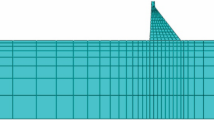Abstract
Considering structural reinforcement, a method is studied to implement the back-analysis for the evolution process of dam material property. From a material point of view, the long-term effect of dam reinforcement can be diagnosed using the proposed method. Firstly, the partial least squares algorithm is introduced to obtain the water level component in the prototype observations of dam safety. Secondly, according to all observations and numerical simulation results on dam behavior before and after dam reinforcement, the time-varying characteristics of dam material parameter are back-analyzed. Based on the subsection back-analysis thought, the improved support vector machine is used to implement the back-analysis of dam material parameter and its evolution process. The procedure and algorithm realizing the above goal are proposed. The material parameter evolution model is built. Lastly, the proposed method and model are applied to evaluate the reinforcement validity and long-term effect of one actual concrete gravity dam which has undergone several dangerous treatments. The numerical simulation is implemented to analyze the structural behavior of the typical dam section. The whole sequences of prototype observations and numerically calculated results are divided into several subsequences and then used to back-analyze the elastic modulus and the evolution process of dam body and its foundation. The evolution model of elastic modulus is established to assess the long-term effect improving the dam material performance by dam reinforcement.










Similar content being viewed by others
References
Ou JP, Li H (2010) Structural health monitoring in mainland China: review and future trends. Struct Health Monit 9(3):219–231
Mata J, Schclar Leitão N, Tavares de Castro A, Sá da Costa J (2014) Construction of decision rules for early detection of a developing concrete arch dam failure scenario. A discriminant approach. Comput Struct 142:45–53
Zhang YB, Wang WB, Zhu Y (2015) Investigation on conditions of hydraulic fracturing for asphalt concrete used as impervious core in dams. Constr Build Mater 93:775–781
Su HZ, Hu J, Wen ZP (2013) Optimization of reinforcement strategies for dangerous dams considering time-average system failure probability and benefit–cost ratio using a life quality index. Nat Hazards 65(1):799–817
Shi LL, Wang LC, Song YP, Shen L (2014) Dynamic multiaxial strength and failure criterion of dam concrete. Constr Build Mater 66:181–191
Wu ZR, Peng Y, Li ZC, Li B, Yu H, Zheng SR (2011) Commentary of research situation and innovation frontier in hydro-structure engineering science. Sci China Ser E 54(4):767–780
Su HZ, Wen ZP, Wu ZR (2011) Study on an intelligent inference engine in early-warning system of dam health. Water Resour Manag 25(6):1545–1563
Gu CS, Li B, Xu GL, Yu H (2010) Back analysis of mechanical parameters of roller compacted concrete dam. Sci China Ser E 53(3):848–853
Li X, Li Y, Chen DW (2009) Application of homotopy parameter inversion method in Miyun reservoir. Glob Geol 12(2):109–111
Faisal H (2010) Empirical relationship between large dams and the alteration in extreme precipitation. Nat Hazards Rev 11(3):97–101
Xu C, Geoffrey Chase J, Rodgers GW (2014) Physical parameter identification of nonlinear base-isolated buildings using seismic response data. Comput Struct 145:47–57
Stojanovic B, Milivojevic M, Ivanovic M, Milivojevic N, Divac D (2013) Adaptive system for dam behavior modeling based on linear regression and genetic algorithms. Adv Eng Softw 65:182–190
Kang F, Li JJ, Xu Q (2009) Structural inverse analysis by hybrid simplex artificial bee colony algorithms. Comput Struct 87:861–870
Su HZ, Hu J, Wu ZR (2012) A study of safety evaluation and early-warning method for dam global behavior. Struct Health Monit 11(3):269–279
Ranković V, Grujović N, Divac D, Milivojević N (2014) Development of support vector regression identification model for prediction of dam structural behaviour. Struct Saf 48:33–39
Su HZ, Wen ZP, Wang F, Wei BW, Hu J (2013) Multifractal scaling behavior analysis for existing dams. Expert Syst Appl 40(12):4922–4933
Mata J, Tavares De Castro A, Sá Da Costa J (2014) Constructing statistical models for arch dam deformation. Struct Control Health Monit 21:423–437
Chisari C, Macorini L, Amadio C, Izzuddin BA (2015) An inverse analysis procedure for material parameter identification of mortar joints in unreinforced masonry. Comput Struct 155:97–105
Cheng L, Zheng DJ (2013) Two online dam safety monitoring models based on the process of extracting environmental effect. Adv Eng Softw 57:48–56
Su HZ, Wu ZR, Wen ZP (2007) Identification model for dam behavior based on wavelet network. Comput Aided Civ Infrastruct 22(6):438–448
Vapnik V (1995) The nature of statistical learning theory. Springer, New York
Martínez López FJ, Martínez Puertas S, Torres Arriaza JA (2014) Training of support vector machine with the use of multivariate normalization. Appl Soft Comput 24:1105–1111
Widodo A, Kim EY, Son JD, Yang BS (2009) Fault diagnosis of low speed bearing based on relevance vector machine and support vector machine. Expert Syst Appl 36(3):7252–7261
Kao LJ, Chiu CC, Lu CJ, Chang CH (2013) A hybrid approach by integrating wavelet-based feature extraction with MARS and SVR for stock index forecasting. Decis Support Syst 54(3):1228–1244
Kuang FJ, Xu WH, Zhang SY (2014) A novel hybrid KPCA and SVM with GA model for intrusion detection. Appl Soft Comput 18:178–184
Paleologu C, Benesty J, Ciochina S (2008) A robust variable forgetting factor recursive least-squares algorithm for system identification. IEEE Signal Proc Lett 15:597–600
Kohli AK, Rai A (2013) Numeric variable forgetting factor RLS algorithm for second-order Volterra filtering. Circ Syst Signal Process 32(1):223–232
Acknowledgements
This research has been partially supported by the National Natural Science Foundation of China (SN: 51579083, 51479054, 41323001), the Doctoral Program of Higher Education of China (SN: 20130094110010), the National Key Research and Development Program of China (SN: 2016YFC0401601), the Open Foundation of State Key Laboratory of Hydrology-Water Resources and Hydraulic Engineering (SN: 20165042112, 20145027612), and the Fundamental Research Funds for the Central Universities (Grant No. 2015B25414).
Author information
Authors and Affiliations
Corresponding author
Rights and permissions
About this article
Cite this article
Su, H., Zhang, S., Wen, Z. et al. Prototype monitoring data-based analysis of time-varying material parameters of dams and their foundation with structural reinforcement. Engineering with Computers 33, 1027–1043 (2017). https://doi.org/10.1007/s00366-017-0514-1
Received:
Accepted:
Published:
Issue Date:
DOI: https://doi.org/10.1007/s00366-017-0514-1




